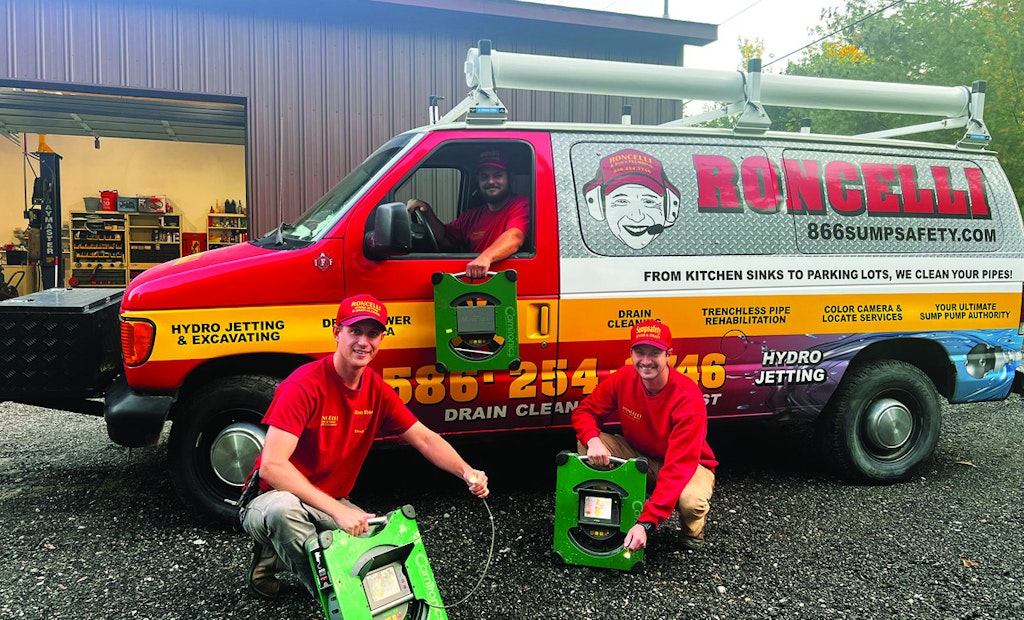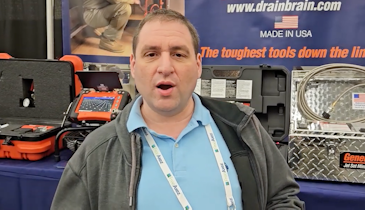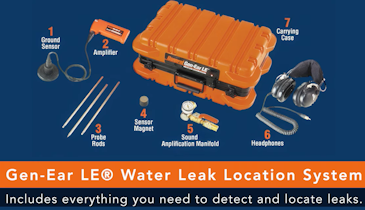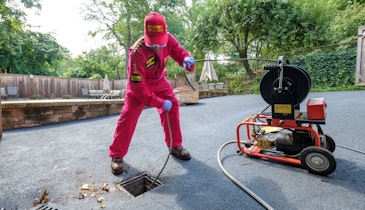
Robbie Roncelli, general manager of Roncelli & Sons Plumbing, left, Mike Vultagio, sewer and drain technicians, center, and Skip Roncelli, sewer and drain technician pose near one of the company work vans with MiniFlex pipeline-inspection camera systems (Camtronics). (Photo courtesy Roncelli & Sons Plumbing)
Interested in Sewer/Drain Cleaning?
Get Sewer/Drain Cleaning articles, news and videos right in your inbox! Sign up now.
Sewer/Drain Cleaning + Get AlertsTrying to diagnose problems in small-diameter pipes with lots of bends used to be mission impossible for Robbie Roncelli, the owner of Roncelli & Sons Plumbing, based in the northern Detroit suburb of Romeo.
But courtesy of the MiniFlex inspection camera from Camtronics, working on small-diameter pipes now is easy — as well as more productive and profitable — for Roncelli, general manager of the company. Roncelli’s father, Ronald, owns the company and established it in 1920.
“Before we bought the MiniFlex, we never could get a camera down, say, a 1 1/2-inch-diameter pipe with bends,” Roncelli says. “We had one camera that we could finesse through a 2-inch straight line, but then it would get stuck in a bend and you’d have to dig it out.
“And that might be under somebody’s kitchen floor, for example.”
So instead, Roncelli had to resort to the old tried-and-true methods, like pulling toilets or using cleanouts to access drainlines. The latter isn’t always a great option in Detroit, where the housing stock is old and cleanouts often have brass caps that strip or break easily, he explains.
“Then you have to cut them off and rework a new one, which takes more time and adds to the cost for customers,” Roncelli says.
Or the veteran plumber would work blind without knowing what was causing clogs.
“It’s absolutely frustrating when you don’t know what the problem is because you don’t know what’s the right tool to use to get the line flowing again,” Roncelli says. “If I can’t get my eyeballs on your kitchen drainline or shower branch line, how do I know what’s going on?
“It left us shooting in the dark and that also caused problems for customers because it costs a lot of money to replace a whole kitchen line that’s in a concrete slab floor, for instance, compared to just cleaning it.”
VISION QUEST
The MiniFlex, which Roncelli purchased through Fiberscope.net, a North American distributor and repair center for Netherlands-based Camtronics, eliminates those pain points.
“The beautiful thing is that it can go through kitchen and bathroom sink lines, shower lines — even a toilet P-trap,” Roncelli explains. “I don’t have to pull toilets anymore, which is incredible.
“We can put the MiniFlex down a sink and inspect the entire main right out to the mainline.”
Furthermore, the MiniFlex is light, compact and portable, which makes it easy to stow in a service vehicle and carry.
“A lot of our other cameras must weigh 60 to 70 pounds, which takes a toll on employees if you have to walk through a large parking lot at a shopping mall, for instance,” he says.
The unit weighs less than 19 pounds and measures about 15 1/2 inches wide by around 18 1/2 inches tall and slightly more than 4 inches deep.
The unit also provides a less tangible but equally important function by differentiating the company from competitors, Roncelli notes.
“I’ve never had a customer tell me another plumber had inspected their smaller lines with a camera,” he says. “So the MiniFlex brings us out on top because we can do things other plumbers can’t.
“The MiniFlex really shines in smaller lines, especially galvanized, copper or cast-iron pipes, which are notorious for getting heavier buildup than PVC pipes,” he adds.
VERSATILE TECHNOLOGY
Roncelli also likes how the small unit’s modular design is packed with features normally not available at a price point of around $5,000.
“A lot of smaller cameras are like toys compared to this one,” he says.
The battery-powered unit, which can operate for seven hours on a full charge, features a high-resolution, 5.6-inch color monitor; 50 feet of push cable (65-, 98- and 131-foot cables also available); a built-in 512 Hz sonde; 12 LED lights; a sapphire-glass, color camera head with 105-degree, wide-angle view; a stainless steel camera head housing; and an on-screen footage counter.
Videos can be downloaded onto an SD storage card for customers, he adds.
The unit’s “secret sauce” is a flexible camera neck that allows it to negotiate tight bends, including multiple 90-degree bends in 1 1/2-inch-diameter pipes and P-traps in 1 1/4-inch-diameter pipes.
“We had one job where a plumber ran PVC pipes like spaghetti noodles,” Roncelli recalls. “I could not could not believe the amount of 90-degree fittings, including a ‘street 90’ plugged right into regular 90-degree fitting.
“I don’t know of another camera that would’ve gotten through all that. … The camera head is incredibly flexible.”
SEEING IS BELIEVING
Roncelli first heard about the MiniFlex several years ago at the WWETT Show in Indianapolis. Was he skeptical?
“Absolutely,” he says. “We’d been down this path before with many other sewer cameras.”
But after buying one MiniFlex and using it for several months, Roncelli bought three more.
“There’s now a MiniFlex on each of our service trucks,” he says, noting his company, which employs five people, serves the northern metropolitan Detroit area and focuses primarily on trenchless sewer-line rehabilitation along with service and repair plumbing.
“These cameras not only help us make more money, but they help us make more money faster,” he explains. “If I can find a blockage faster and avoid cutting any sink fittings or pulling a toilet, for example, I can give customers a quote faster and get to work faster.
“And if they don’t want me to do the work, I haven’t wasted a lot of time and can get on to the next job and start making money.”
Knowing the condition of pipes before work begins makes for happy customers — and a successful business, Roncelli adds.
“It’s a game-changer, for sure,” he says. “It saves us a lot of time and saves customers a lot of money. It’s definitely a win-win.”





